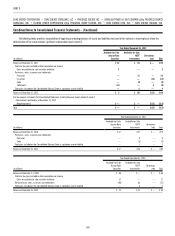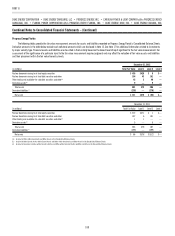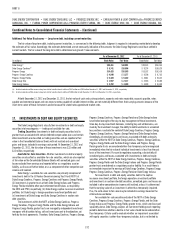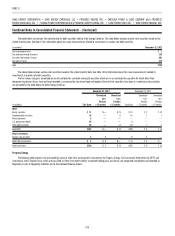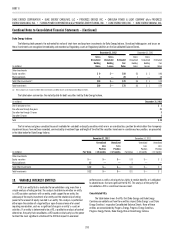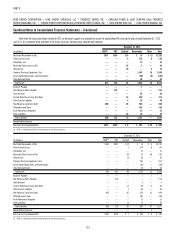Duke Energy 2012 Annual Report Download - page 213
Download and view the complete annual report
Please find page 213 of the 2012 Duke Energy annual report below. You can navigate through the pages in the report by either clicking on the pages listed below, or by using the keyword search tool below to find specific information within the annual report.
193
PART II
DUKE ENERGY CORPORATION • DUKE ENERGY CAROLINAS, LLC • PROGRESS ENERGY, INC. • CAROLINA POWER & LIGHT COMPANY d/b/a PROGRESS ENERGY
CAROLINAS, INC. • FLORIDA POWER CORPORATION d/b/a PROGRESS ENERY FLORIDA, INC. • DUKE ENERGY OHIO, INC. • DUKE ENERGY INDIANA, INC.
Combined Notes to Consolidated Financial Statements – (Continued)
the length of time over which the market value has been lower than the cost
basis of the investment, the percentage decline compared to the cost of the
investment and management’s intent and ability to retain its investment in the
issuer for a period of time suffi cient to allow for any anticipated recovery in
market value. If a decline in fair value is determined to be other-than-temporary,
the investment is written down to its fair value through a charge to earnings.
With respect to investments in debt securities, under the accounting
guidance for other-than-temporary impairment, if the entity does not have an
intent to sell the security and it is not more likely than not that management
will be required to sell the debt security before the recovery of its cost basis,
the impairment write-down to fair value would be recorded as a component
of other comprehensive income, except for when it is determined that a
credit loss exists. In determining whether a credit loss exists, management
considers, among other things, the length of time and the extent to which the
fair value has been less than the amortized cost basis, changes in the fi nancial
condition of the issuer of the security, or in the case of an asset backed
security, the fi nancial condition of the underlying loan obligors, consideration
of underlying collateral and guarantees of amounts by government entities,
ability of the issuer of the security to make scheduled interest or principal
payments and any changes to the rating of the security by rating agencies. If
it is determined that a credit loss exists, the amount of impairment write-
down to fair value would be split between the credit loss, which would be
recognized in earnings, and the amount attributable to all other factors, which
would be recognized in other comprehensive income. Management believes,
based on consideration of the criteria above, that no credit loss exists as of
December 31, 2012 and December 31, 2011. Management does not have
the intent to sell such investments in auction rate debt securities and the
investments in debt securities within its captive insurance investment portfolio
and foreign operations investment portfolio, and it is not more likely than not
that management will be required to sell these securities before the anticipated
recovery of their cost basis. Management has concluded that there were no
other-than-temporary impairments for debt or equity securities necessary as
of December 31, 2012 and December 31, 2011. Accordingly, all changes in the
market value of investments other than the NDTF at Duke Energy Carolinas,
Progress Energy Carolinas, Progress Energy Florida and the Duke Energy Indiana
and Progress Energy Florida grantor trusts were refl ected as a component of
other comprehensive income in 2012 and 2011.
See Note 16 for additional information related to fair value measurements
for investments in auction rate debt securities.
Short-term and Long-term investments. Investments in debt and
equity securities are classifi ed as either short-term investments or long-term
investments based on management’s intent and ability to sell these securities,
taking into consideration illiquidity factors in the current markets.
Duke Energy holds corporate debt securities which were purchased using
excess cash from its foreign operations. These investments are classifi ed as
Short-term investments on the Consolidated Balance Sheet and are available
for current operations of Duke Energy’s foreign business. The fair value of these
investments was $ 333 million as of December 31, 2012 and $190 million as of
December 31, 2011.
Duke Energy classifi es its investments in debt and equity securities held
in the NDTF at Duke Energy Carolinas, Progress Energy Carolinas, Progress
Energy Florida, the Duke Energy Indiana and Progress Energy Florida grantor
trusts and the captive insurance investment portfolio as long-term. Additionally,
Duke Energy has classifi ed $29 million carrying value ($34 million par value)
and $71 million carrying value ($89 million par value) of investments in auction
rate debt securities as long-term at December 31, 2012 and December 31,
2011, respectively, due to market illiquidity factors as a result of continued
failed auctions, and since management does not intend to use these
investments in current operations. All of these investments are classifi ed as
available-for-sale and, therefore, are refl ected on the Consolidated Balance
Sheets at estimated fair value based on either quoted market prices or
management’s best estimate of fair value based on expected future cash fl ow
using appropriate risk-adjusted discount rates.




